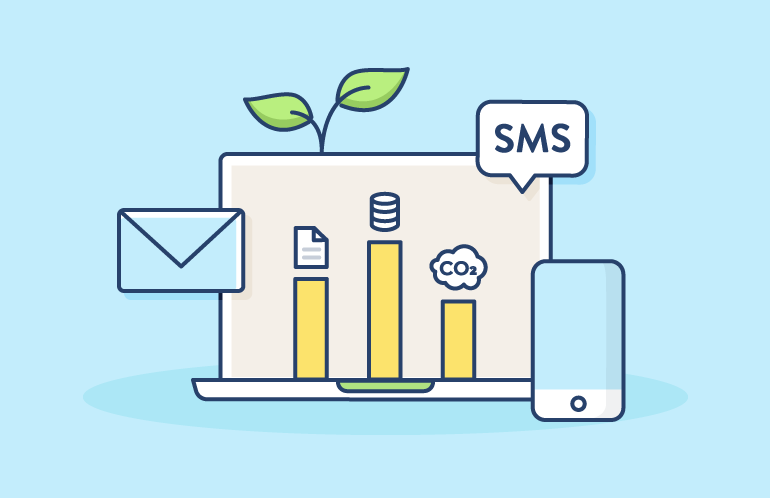How to calculate the environmental impact of your CRM program?


Catégorie : Tendances marché
The environmental impact of our actions is a fundamental subject, too often neglected in our marketing actions. Today, how can we live, think, and work without taking into account our environmental impact, whether personal or professional?
I often wonder what role we marketers can play in this ecological awareness and whether we could, in our own way, modify our practices to make them more environmentally friendly. And since I don’t like unanswered questions, I did some research on the subject.
The carbon impact of a CRM program is not neutral and its weight is defined by the sum of the weight of each of the channels that are activated.
That sounds rather logical.
Now let’s take a look at the carbon cost of an email.
Data centers consume a lot of energy, especially to refrigerate all the computers needed for a huge processing power.
It is therefore the infrastructure necessary for sending and receiving emails that explains a lot of these significant carbon expenses.
The carbon weight of an email varies according to several factors:
Let’s take an example. An email composed of text only has an average weight of 5g carbon.
It can go up to 50g carbon for an email with a 1Mo attachment.
ADEME (“Agence de la transition écologique” in France) has defined an average figure of 10g carbon per email sent, which can be used as a basis if you wish to measure the carbon footprint of your CRM program.
The number of recipients is the second factor that can impact the carbon cost of an email.
Still according to ADEME, multiplying by 10 the number of recipients of an e-mail multiplies its carbon impact by 4.
Finally, the storage time of an e-mail is the last factor.
The longer an email is kept in the recipients’ inbox, the greater its environmental impact will be.
This data can become particularly energy-consuming, multiplied by the number of recipients of your CRM campaigns!
Indeed, while email remains the channel most exploited by CRM programs, other marketing channels also have a carbon footprint.
I’ve put together some information that can help you measure the carbon impact of your other channels.
Sending paper catalogs and flyers remains one of the marketing channels commonly used, particularly in sectors such as fashion, furniture, banking and insurance.
The two factors that most influence the carbon cost of these shipments are the weight of the shipment and the distance the shipment travels.
For example, sending a 100-gram green-letter catalog from Paris to Marseille will weigh 23.3 grams of CO2.
And that of course does not include the carbon cost of creating and printing your catalog, as well as the non-renewable resources consumed in its production, especially paper.
If you are interested, the French post proposes an easy-to-use calculator to calculate the carbon footprint of your mailings.
SMS seems to be a greener channel.
Mike Berners-Lee, researcher and brother of Tim Berners-Lee, inventor of the Internet and author of a book on the environmental footprint of everyday products, estimates the carbon footprint of an SMS to be 0.014 grams of carbon.
Other figures published by Vodafone on the electricity consumption required to transport SMS messages in 2009, converted into CO2 emissions, attribute to each SMS an emission of 0.00215 grams of CO2.
It’s hard to know which figure to rely on, but in both cases, this value remains low compared to the 10 grams of carbon estimated for sending an e-mail.
To be on the safe side, if you want to calculate the carbon cost of your CRM program, I would recommend Mike Berners-Lee’s pessimistic approach of 0.014 grams of carbon.
Another channel is becoming increasingly important in multi-channel marketing CRM strategies: web push notifications.
Unfortunately, there isn’t much information available on the subject yet.
Like SMS, and for lack of more precise data, it seems reasonable to me for those of you who want to evaluate their carbon impact to consider that a push made up of text only has a carbon weight relatively close to that of an SMS.
Armed with all this data, you can now approach the calculation of the overall carbon cost of your CRM programs, by channel and over time.
It’s quite simple, you just need to multiply your distribution volumes by the estimated carbon cost per channel, for each of your mailings.
Bad news: if all goes well for your company, your carbon cost should only increase…
Even if you don’t implement immediate measures to optimize the cost of your mailings, I think that this data is essential today and should be communicated internally within companies, to make teams aware of the impact of their work.
The environmental cost of digital channels is too often a fact that we ignore, and bringing awareness in the marketing field could change the situation.
Why not for instance create an index of the environmental performance of companies’ CRM programs, in the same way, for example, that a vignette has been created to categorize cars according to their emissions?
One thing is sure, I am passionate about this subject and I will continue to share with you regularly my findings about the environmental impact of CRM programs.